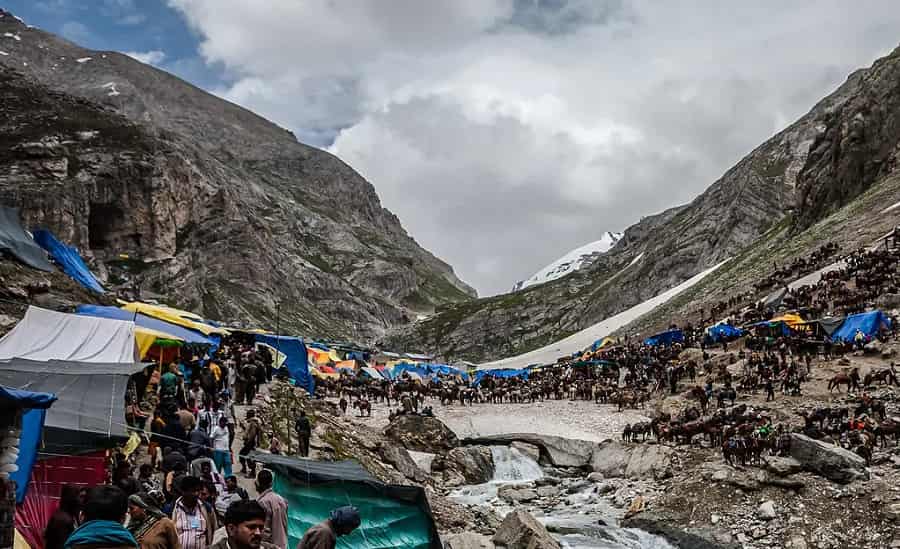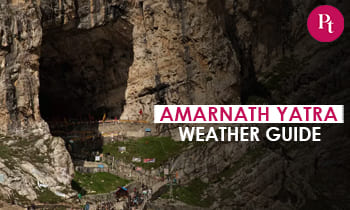Embarking on a spiritual journey to the sacred Amarnath Cave, situated in the pristine Himalayan mountains, is a revered pilgrimage for countless devotees. The mystical aura of the cave, coupled with its challenging terrain, demands thorough preparation, particularly with regards to the unpredictable weather conditions that can swiftly change. This comprehensive guide aims to equip pilgrims with invaluable insights into the fluctuating weather patterns, essential packing recommendations, and crucial safety measures to ensure a spiritually enriching and safe pilgrimage.
Understanding the Amarnath Weather
Amarnath Current Weather
A Land of Contrasts
The Amarnath region boasts a geographical diversity that gives rise to a wide spectrum of weather patterns. During the summer months, which typically span from June to August, pilgrims are greeted with mild and comfortable daytime temperatures ranging between 15°C to 20°C (59°F to 68°F). The nights, however, take on a crisper character, with temperatures descending to approximately 5°C (41°F). It’s noteworthy that even in the summer, sudden fluctuations in temperature are not uncommon, necessitating the adoption of a layered approach to clothing for both comfort and adaptability.
Amarnath in Summers (April to June)
Amarnath in the summer season is a breathtaking destination where spirituality and nature intertwine. With temperatures ranging from a refreshing 12 to 18 degrees Celsius during the day, pilgrims and nature enthusiasts alike flock to the revered Amarnath Cave. The sacred ice lingam, believed to represent Lord Shiva, remains a focal point of devotion amidst the picturesque landscapes. The surrounding meadows and the glistening Lidder River further enhance the serene ambiance, offering a perfect escape from the summer heat.

Amarnath in Monsoons (July- to September)
Monsoon season, extending from July to early September, paints the region in vibrant hues of green as the hillsides come alive with lush foliage. However, this period also ushers in heavy rainfall, posing challenges for pilgrims who plan to undertake the trek. The trails can become slippery and treacherous, and the risk of landslides looms large. Consequently, pilgrims are advised to exercise caution and consider alternate travel times.
As the monsoon recedes and gives way to post-monsoon (September to October), the landscape transforms once more. Clearer skies and diminished rainfall make this time optimal for the pilgrimage. Temperatures undergo a gradual decline, with daytime readings stabilizing around 10°C to 15°C (50°F to 59°F), while nights invite a chill, often dipping below freezing.
Amarnath in Winters (November to April)
Winter envelops the region from November to April, endowing it with a serene and ethereal beauty. However, the heavy snowfall that blankets the area renders the cave inaccessible during this period. Pilgrims seeking to undertake the journey during winter should diligently monitor official announcements for the opening dates of the pilgrimage and remain attuned to weather forecasts.
Amarnath Month wise Weather Details
May: As heavy snow around the Amarnath region begins to melt, the climate becomes hospitable. Days are warm with minimal chances of rainfall, but heavy woolens are still required due to the lingering cold.
June: The weather warms up, and much of the snow melts away, marking the start of the Amarnath pilgrimage season. The landscape begins to bloom, enhancing the beauty of the Amarnath region.
July: The Amarnath Yatra is in full swing during this month, with generally pleasant weather. However, unpredictable monsoon conditions can occasionally halt the pilgrimage until the weather clears.
August: As the two-month-long Amarnath Yatra concludes around mid-August, the weather remains pleasant. Yet, impending monsoon effects bring light drizzles and the possibility of cloudbursts.
September: Fresh and beautiful, with occasional rainfall. The climate is moderately cold, indicating the approaching winter. Roads leading to the Amarnath region close as winter draws near.
October: The weather grows colder with the onset of winter in the Amarnath region. Green pastures recede, and snow accumulation gradually starts.
November: Extremely cold with heavy snowfall covering the region. The surroundings become inhospitable due to the thick layers of snow.
December: The climate turns extremely cold, with temperatures well below freezing. Snow blankets the roads and the region, creating a harsh environment.
January: Freezing temperatures persist, accompanied by heavy snowfall. The weather remains harsh and devoid of vegetation.
February: The severe cold continues, with heavy snowfall and no signs of vegetation in the region.
March: Winter starts to recede gradually, although freezing temperatures and heavy snowfall persist. Signs of spring emerge as temperatures begin to rise.
April: The winter slowly relinquishes its grip as snow starts to melt. Although the landscape retains a thin layer of snow, temperatures rise slightly. Nights remain chilly.
Best Time to Visit Amarnath Dham
The best time to visit Amarnath Dham is during the summer months of June to August. This period is considered ideal for the pilgrimage due to milder weather conditions and the opening of the Amarnath Cave shrine for devotees. The cave, located in the Himalayas in Jammu and Kashmir, remains covered in snow for most of the year and becomes accessible only during this time. The Amarnath Yatra, a significant religious journey, takes place during this period, attracting thousands of devotees. It’s advisable to plan your visit during these months to avoid extreme cold and snowfall that can make the journey difficult and dangerous.
FAQs
1. Can the Amarnath Cave be visited during the winter months?
No, the Amarnath Cave is inaccessible during the winter months due to heavy snowfall and the ensuing extreme weather conditions. The pilgrimage typically resumes when the cave is once again accessible.
2. Is trekking advisable during the monsoon season?
Trekking during the monsoon season, which spans from July to early September, poses challenges due to heavy rainfall. The trails can become slippery, and the risk of landslides increases. Pilgrims are encouraged to consider alternate travel times or consult local authorities for the most up-to-date advice.
3. How should I prepare for sudden temperature changes?
Given the possibility of abrupt temperature fluctuations, layering your clothing is crucial. This enables you to adapt to changing conditions by adding or removing layers as needed, ensuring both comfort and preparedness.
4. Are there medical facilities available along the trek?
While basic medical facilities might be available along the route, it’s advisable to carry a well-stocked first aid kit containing medications for common ailments such as altitude sickness, cold, and fever. Prior consultation with a medical professional is recommended to tailor the medical kit to your individual needs.
5. What is the significance of Amarnath Cave?
The Amarnath Cave holds immense spiritual significance for Hindus. It is believed to be the abode of Lord Shiva in the form of an ice lingam, which waxes and wanes with the phases of the moon. The pilgrimage to this sacred site is a testament to the devotees’ unwavering faith and dedication.












 Call
Call WhatsApp
WhatsApp Enquiry
Enquiry